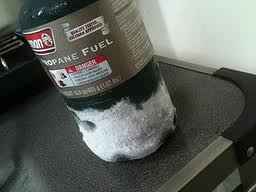Why Does Ice Form on the Outside of a Propane Tank?
20th Aug 2019
Why does ice form on the outside of a propane tank?
First you need to know some facts about propane.
- When using a propane appliance, the burning processes draws vapor from the top portion of your tank.
- Liquid propane which sets in the lower portion of the tank, then begins to release replacement vapors. As the liquid propane absorbs heat from the walls of your tank, the propane vapor is released which rises to the top of the tank, ready for use by your appliance.

So why does the external walls of the tank freeze?
- If your vapor withdrawal rate for your appliance is greater than the liquid conversion rate, the tank walls will begin to freeze.
- Why? Because the liquid propane is demanding more and more warmth and it attempts to draw that heat from the tank walls. Propane's ability to draw heat is in direct relationship to the ambient temperature out side of the tank and the amount of wet surface (surface in contact with liquid propane) inside of the tank.
What is the solution?
Stop using the propane tank and allow for it to absorb heat from the air until the ice is gone.
For applications using small cylinders, simply hook-up a spare tank. For applications that require large tanks, install a larger tank on the supply gas line to adequately accommodate the BTU demand of all of the appliances on the system.
Did you find this interesting? Why not receive our newsletter so you can be well informed about propane and its safe use.
